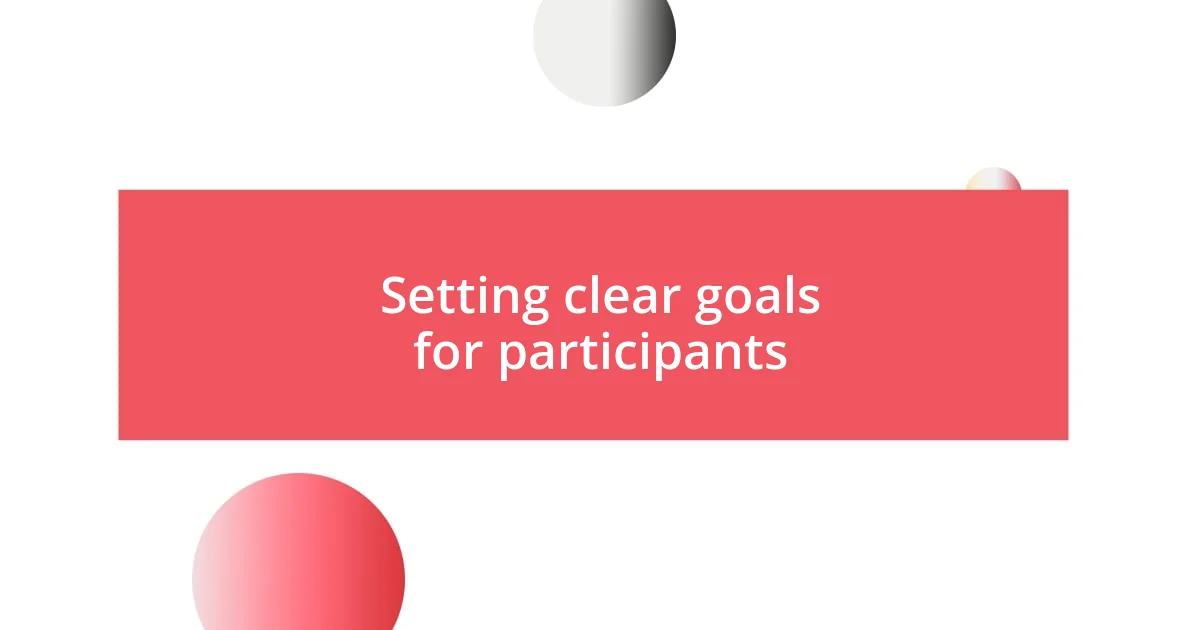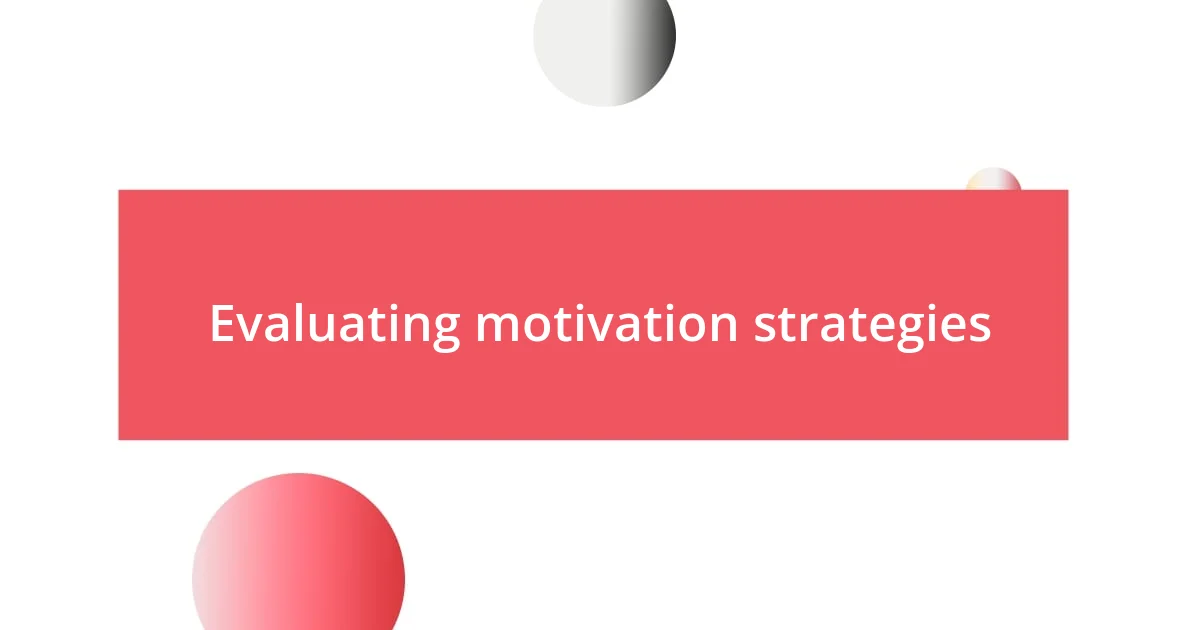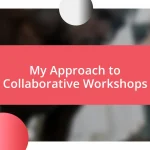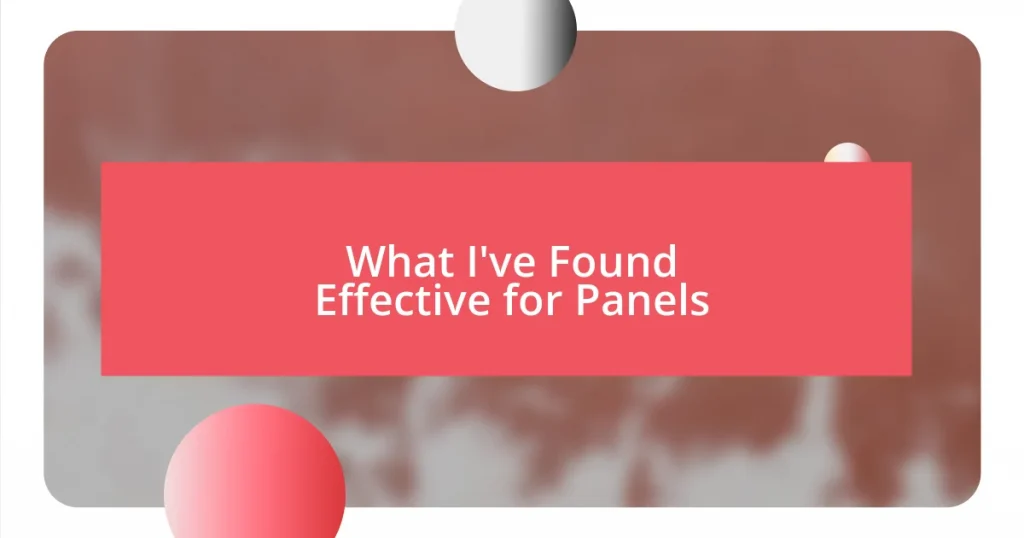Key takeaways:
- Understanding participant motivation involves recognizing both intrinsic factors and personal connections to enhance engagement.
- Setting clear, collaborative goals fosters a sense of purpose and boosts motivation, transforming tasks into shared challenges.
- Creating a positive environment through trust, recognition, and open communication significantly increases participant involvement and enthusiasm.

Understanding participant motivation
Understanding participant motivation is a complex but rewarding process. Reflecting on my own experiences, I’ve often found myself considering what truly drives individuals to engage in various activities. For instance, during a community workshop I facilitated, I noticed that participants were most motivated when they felt a personal connection to the topic. This made me realize that tapping into their interests and experiences could significantly enhance their engagement.
I’ve also learned that motivation goes beyond the surface. It’s not just about external rewards; it’s deeply tied to intrinsic factors. I often ask myself, “What inspires these participants to attend?” In one project, I made it a point to ask participants about their goals. Their answers revealed hidden passions and aspirations, which I could weave into the sessions to keep them engaged.
There are times when I’ve seen enthusiasm wane, and that’s a critical moment for reflection. How can I reignite that spark? I remember a participant who initially showed excitement but later seemed detached. By checking in with them and understanding their concerns, I was able to reshape the content which ultimately led to a renewed sense of purpose. It’s these moments that highlight the importance of empathy in understanding what motivates participants.

Setting clear goals for participants
Setting clear goals is essential for keeping participants motivated. I’ve realized that when I establish specific, achievable objectives, it creates a roadmap for everyone involved. For instance, in a recent team-building workshop, we collectively defined our goals at the outset, which not only aligned our expectations but also fostered a shared sense of purpose. Participants expressed that having a clear destination made the journey more engaging and actionable.
Here are some key points I consider when setting goals:
– Be Specific: Define the objectives in clear terms so that everyone understands what is expected.
– Make Them Measurable: Goals should have tangible outcomes to track progress.
– Ensure Relevance: Align goals with participants’ personal interests or professional aspirations.
– Set Timeframes: Establish deadlines that create a sense of urgency and commitment.
– Encourage Collaboration: Involve participants in the goal-setting process to enhance buy-in and ownership.
In my experience, involving participants in these discussions creates a deeper emotional connection to their goals. During one workshop, participants collaborated to develop personal milestones, which sparked a lively atmosphere filled with shared excitement. This not only made the journey more engaging but also turned mere tasks into collaborative challenges. It’s amazing how clarity can transform motivation, don’t you think?

Creating a positive environment
Creating a positive environment can significantly enhance participant motivation. From my perspective, fostering a supportive atmosphere starts with building trust. In a recent workshop I ran, I made it a point to acknowledge everyone’s contributions, no matter how small. When participants felt their voices mattered, I could see the shift in energy; laughter filled the room, and the interactions became more genuine and fluid. It was like a ripple effect—participants began encouraging one another, which made a noticeable difference in the overall vibe.
Another key aspect is celebrating achievements, both big and small. I recall a time when I organized a mid-session check-in, where participants could share their progress or breakthroughs. It was heartwarming to witness the pride and enthusiasm on their faces as they recounted their stories. I have come to appreciate that these moments don’t just elevate individual spirits; they weave a stronger group bond that keeps everyone engaged and excited to contribute.
Additionally, incorporating fun elements can lighten the atmosphere significantly. In one project, I introduced creative icebreakers that got everyone moving and laughing. I found that when participants are relaxed and having fun, they become more open to collaboration and sharing their ideas. This hands-on approach helped solidify the group’s connection while cultivating an environment where motivation thrives.
| Element | Impact |
|---|---|
| Building Trust | Encourages participation and genuine interactions |
| Celebrating Achievements | Enhances motivation and fosters group cohesion |
| Incorporating Fun | Creates a relaxed atmosphere, boosting creativity and teamwork |

Utilizing rewards and recognition
Utilizing rewards and recognition can be a game-changer in keeping participants motivated. I vividly remember a project where we introduced a points system: participants earned points for contributions, like sharing insights or helping others. This simple approach not only sparked friendly competition but also fostered a community spirit as everyone cheered each other on. Isn’t it fascinating how a little acknowledgment can lead to a big boost in enthusiasm?
On a more personal note, I’ve seen the profound impact of public recognition. During a team meeting, I made it a point to highlight individual achievements, sharing specific examples of how their efforts contributed to our collective success. The pride on their faces was palpable, and it transformed their energy in the room. They left the meeting not just with a sense of accomplishment but with renewed motivation to push the project forward. It’s amazing what a few kind words can do, isn’t it?
Moreover, I often think about how intrinsic and extrinsic rewards work hand-in-hand. For instance, I’ve noticed that when participants receive tangible rewards—like gift cards or certificates—alongside meaningful recognition, it elevates their commitment. One time, we had a ‘participant of the month’ spotlight, which not only honored individual contributions but also inspired others to strive for the same recognition. This blend of rewards creates an environment where everyone is not just involved but eager to excel, don’t you think?

Encouraging open communication
Encouraging open communication is essential, as it lays the groundwork for collaboration and creativity. I remember a team brainstorming session where I invited everyone to share their thoughts, regardless of their role. To my surprise, one of the quieter members sparked an incredible idea that reshaped our project direction. It made me realize that sometimes, it just takes a little encouragement for voices to be heard.
I’ve found that implementing regular check-ins can dramatically enhance communication. In my experience, I always make it a point to ask everyone how they’re doing—both personally and professionally. One time, during a particularly challenging phase, a participant opened up about their struggles. This honesty not only deepened our connection but also fostered a supportive atmosphere where others felt safe sharing their own challenges. It made me wonder: what if we created more spaces for such honest conversations?
Moreover, I discovered that using anonymous feedback tools can encourage candid sharing. During one of my workshops, I set up a digital suggestion box, allowing participants to voice their opinions without fear of judgment. The insights I received were eye-opening, and they led to immediate improvements. It was empowering to know that I could create a space where everyone felt comfortable expressing themselves. Isn’t it remarkable how such simple strategies can evoke a wealth of ideas?

Providing regular feedback
Providing regular feedback is one of the most powerful ways to keep participants motivated. I recall a project where I instituted a weekly feedback loop. Participants would share their accomplishments, and I would respond with constructive feedback—in real time! This not only made them feel seen but also encouraged continuous improvement. It’s interesting how a simple practice like this can amplify enthusiasm and involvement.
In another instance, I remember how I tailored my feedback to match individual preferences. Some participants thrived on detailed critiques, while others appreciated a more general acknowledgment of their efforts. Noticing this difference allowed me to connect with them on a more personal level, making my feedback feel more relevant and impactful. Why settle for generic responses when a little personalization can go such a long way?
Moreover, I find that incorporating peer feedback is beneficial as well. During one session, I arranged for participants to give each other feedback after their presentations. The camaraderie that unfolded was incredible! They were not only active listeners but also offered valuable perspectives, reinforcing their sense of belonging to the group. Isn’t it amazing how peer recognition can enhance motivation and strengthen relationships among participants?

Evaluating motivation strategies
Evaluating motivation strategies is a continuous journey. In my experience, I often reflect on what works and what doesn’t. For instance, I once initiated a pilot program where I tested various incentive structures, from performance-based rewards to team-building outings. The real eye-opener came when I realized that personal recognition, like handwritten notes of appreciation, sparked more genuine enthusiasm among participants than any formal reward could. How often do we underestimate the power of a simple ‘thank you’?
Another aspect I’ve found crucial is monitoring engagement levels regularly. I’ve conducted quick pulse surveys to gauge how motivated participants felt after implementing different strategies. One particular survey revealed that while some were drawn to financial incentives, others craved more intrinsic rewards, like professional growth opportunities. This taught me that it’s essential not just to offer a one-size-fits-all solution but to adapt strategies based on what truly resonates with each individual.
I’ve also started to keep a log of motivation tactics we’ve employed, analyzing the outcomes over time. This reflective practice has been invaluable; for instance, when we experimented with gamification, I noted both excitement and frustration levels among participants. By evaluating these emotions and responses, I was able to tweak our approach, ensuring everyone felt included in the fun. Isn’t it fascinating how evaluating our strategies can lead to richer, more fulfilling experiences for everyone involved?















